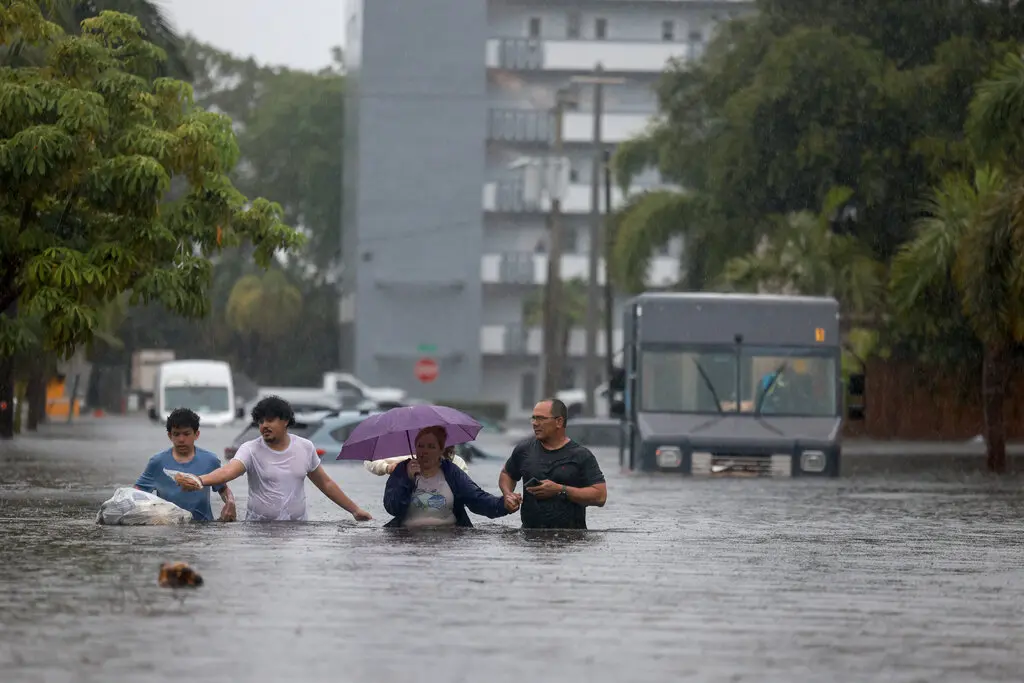Miami’s Historic Flooding: An Unprecedented Crisis
On May 8, 2024, the vibrant city of Miami, Florida, faced a catastrophic event that many residents will not soon forget. Historic flooding swept through the area after an astounding 15 inches of rain fell in less than 24 hours. As a result, the city found itself grappling with the worst storm-related disaster in its history, leaving streets submerged and community infrastructure battered. Residents awoke to a scene reminiscent of disaster films, the impacts of which are becoming more indicative of the challenges posed by climate change.
Impact on Infrastructure
The torrential rains began late on May 7, overwhelming Miami’s drainage and stormwater management systems. Downtown Miami, often characterized by its bustling streets and impressive skyline, quickly transformed into a network of rivers. In certain neighborhoods, floodwaters rose to waist-deep levels, submerging homes and businesses. The flooding disruptions extended to major transport hubs, leading to the temporary suspension of operations at Miami International Airport, where runways found themselves underwater. As a precautionary measure, educational institutions throughout the region closed their doors indefinitely.
State of Emergency Declared
Amid escalating challenges, city officials promptly declared a state of emergency early Wednesday morning. They urged residents to stay indoors and refrain from all non-essential travel. During a press briefing, Miami’s mayor, Daniella Levine Cava, expressed concern regarding the sheer magnitude of the flooding. “This is a climate emergency we’ve been warning about for years,” she stated, highlighting that existing infrastructure is not equipped to handle such severe weather incidents. Mayor Cava asserted that the city administration is mobilizing resources to address the crisis and prioritize public safety.
Rescue Operations Underway
Within hours of the flooding, rescue operations commenced, focusing on evacuating residents stranded in their homes and vehicles. Emergency responders worked tirelessly to reach individuals trapped by rising waters. The involvement of the Coast Guard became crucial in assisting recovery efforts in the hardest-hit neighborhoods, including Brickell, Little Haiti, and parts of South Beach. As emergency services continued to navigate through the floodwaters, their dedication was a testament to local commitment during these harrowing times.
A Wake-Up Call for Climate Resilience
The catastrophic flooding significantly reignited discussions about Miami’s vulnerability to extreme weather events and ongoing climate change. Environmental advocates and local leaders expressed grave concerns about the city’s preparedness for such emergencies, advocating for enhanced climate resilience measures. Community activist Maria Torres stated, “Miami has no time to waste. This is not just a storm; this is a glimpse of our future.” The disastrous event has thus served as a poignant reminder of the urgent necessity for improved infrastructure and emergency preparedness strategies to combat increasingly frequent climate-related threats.
The Road Ahead for Miami
As the city begins to assess the extensive damage incurred, the immediate focus is on providing aid and support to those affected. The flooding has left the community grappling not only with physical destruction but also with the emotional and psychological toll of such a traumatic experience. In the face of this crisis, conversations around the future of Miami’s infrastructure and resources are likely to be revitalized, setting the stage for potential legislation and action aimed at sustainable growth and resilience.
Conclusion
The unprecedented flooding in Miami has underscored the vulnerabilities that many cities across the globe face due to the onset of climate change. As the city navigates through the recovery process, it becomes essential for local leadership and community members to reflect on the lessons learned from this crisis. Building resilience through improved infrastructure, refined emergency management strategies, and proactive climate policies will be critical in safeguarding Miami against future natural disasters. The events of May 2024 will serve as a stark reminder of the challenges ahead and the pressing need for concerted efforts to address the escalating impact of climate change on urban environments.
FAQs
What caused the flooding in Miami?
The flooding was primarily caused by record-breaking rainfall, with over 15 inches falling in less than 24 hours, overwhelming the city’s drainage systems.
What actions are being taken by the city government in response to the flooding?
The Miami city government has declared a state of emergency, mobilized emergency services for rescue operations, and is working to assess the damage in the wake of the disaster.
Are there resources available for affected residents?
Yes, local officials and emergency services are providing assistance to residents impacted by the flooding, including evacuation support and emergency shelters.
What does this flooding mean for Miami’s future regarding climate change resilience?
This incident has reignited important discussions about the necessity for stronger climate resiliency measures and infrastructure improvements to help the city withstand future extreme weather events.
How can residents prepare for potential future flooding events?
Residents are encouraged to stay informed about their local weather conditions, have an emergency kit ready, and create a family emergency plan to ensure safety during extreme weather events.

